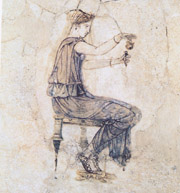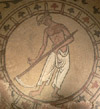
BEAUTY TREATMENTS
The Romans considered very important concept of beauty and personal care for that.
Ovid reminded girls You can do yourself untold damage when you laugh if your teeth are black, too long or irregular, advising them not open their mouths when they laughed, but to show dimpled cheeks instead. Elegant ladies would take a morning bath for which few other Romans had any facilities, after which they would be rubbed down and massaged. Some might have superfluous hair removed by rubbing with pumice stones, a practice which calls to mind the French saying that beauty is to be had only at the price of pain. But razors and drugs such as bryonia were also used. Plucked eyebrows were accepted as an aid to beauty as early as the first century B.C.
.
Efforts to preserve and beautify the hair were carried to great lengths by both sexes in the Roman Empire. The most extraordinary concoctions were prepared under age old illusion that hair can be made to grow by anointing the scalp with oils, greases or fluids. Marrow from deer bones, fat from animals such as bears and sheep were recommended. One repulsive remedy was made from rats' heads, rats' excrement, hellebore and pepper. In spite of all precautions, Roman men and women continued to lose their hair. False hair and wigs, like false teeth, incited the sarcasm and scorn of those in no need of such aids. The sight of the bald head of a great personage whose wig had been blown off by the wind was thought sufficiently funny to warrant commemoration in verse, just as Ovid could not resist recording that he once called unexpectedly on a lady friend who, in her hurry, put her wig on the wrong way round. Women with scanty locks should keep their doors well-guarded was his advice. Those well endowed with woman's crowning glory, however, might with advantage, he declared,
allow an audience while it was being combed by industrious slaves who would use elegant combs made from boxwood, ivory or tortoise shell. Curling irons, mentioned by Plautus in the second century B. C. were in general use. Cicero a hundred years later mentioned that some effeminate men also used them.
The great variety of hairstyles was a bewildering during the late Roman Republic and throughout the Empire as it is today and it excited just as much jaundiced comment from some of the men whom it was supposed to attract. There is no specifically Roman, as there was a Greek style, because fashions continually changed. So much so that a sculptor was known to allow for it by producing a sculptured portrait of a Roman lady with a detachable scalp so that it would be kept up to-date as new hair style came into fashion. Young girls and women of good families often tied a white or purple fillet around their heads.
The dressing-table of an elegant woman was covered with rows of pretty little boxes and caskets containing all manner of beauty aids, because face powder, scent and make-up were used lavishly. Sometimes they were crudely applied with little taste of skill and some did not stand up to great heat or bad weather, again inviting damaging comments. While Fabella, smeared with chalk, fears the rain, said Martial with scant gallantry, 'Sabella’s rough fears the sun. The tasteless use of heavy perfume caused Cicero to say: The right scent for a woman is none at all, but as other Romans knew, it depended on the woman and perhaps the weather, and the frequency of her visits to the Baths. Darkening the eyes and prolonging the arch of the eyebrows with some blackening material were also tricks at which Roman girls were adept. Some stuck black patches or beauty-spots on their faces, particularly if they had some small blemish to hide. Other relied upon a rich display of heavy jewellery to add to their distinction. Some indeed overloaded themselves with a great wealth of heavy gems, whether he occasion for their display was fitting or not. Pearls and emeralds were greatly prized, but diamonds were little used because no way had been found of cutting and polishing the stones. The twenty-first century would not have had much to teach Roman girls about art of personal display, from bikinis to make-up, but the Romans would no doubt envy the modern age for its greater skill in producing beauty-aids and in making many of them available cheaply, for all classes. Among the many modern improvements would be the mirror. The Romans had no discovered how faithful a reflection can be obtained from a film of mercury behind polished glass and they had to rely upon highly polished metal. Their mirrors were mostly small hand-mirrors, but larger wall-mirrors were also known.






